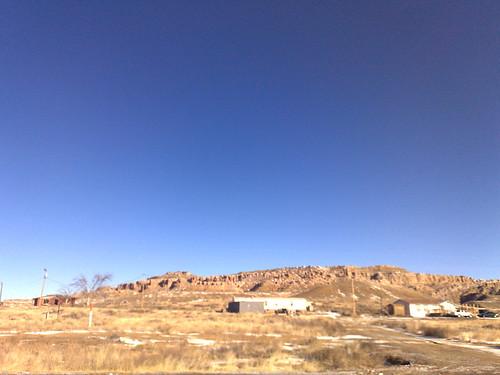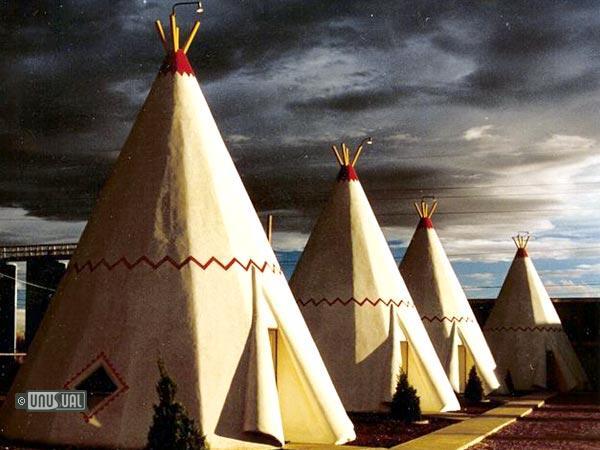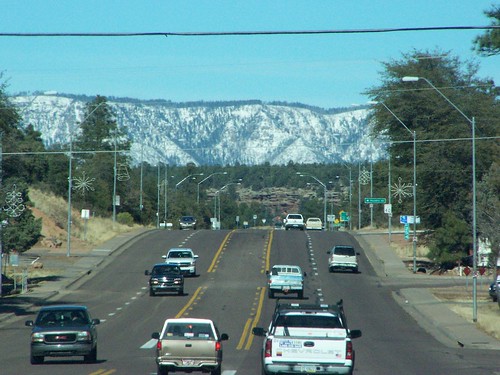Blue Highways: Polacca, Hopi Reservation
Unfolding the Map
Click on Thumbnail for MapWe are now traveling with William Least Heat-Moon (LHM) through miles and miles of reservation. We are still in Arizona, but we are on sovereign nations within the state. We pass through the Navajo Nation and in the middle of it, we find the Hopi Reservation. We'll slow down as we pass by Polacca, and think about how tribes like the Hopi are trying to preserve their culture and teach others about it, all while holding on to those things that ensure their ways of life and traditions will last. To see where we've come, click on the map thumbnail at right.
Book Quote
"Although the Hopi have lived here far longer than any other surviving people and consider their mile-high spread of rock and sand, wind and sun, the center of the universe, they are now, by Anglo decree, surrounded by their old enemies, the Navajo, a people they see as latecomers.
"Holding on to their land has been a long struggle for the Hopi....But recently they have fought Navajo expansion in federal courts, and a strange case it is: those who settled first seeing judgment from those who came later thorugh laws of those who arrived last.
"Because the Navajo prefer widely dispersed clusters of clans to village life, I'd seen nothing resembling a hamlet for seventy-five miles. But Hopi Polacca almost looked like a Western town in spite of Indian ways here and there: next to a floral-print bedsheet on a clothesline hung a coyote skin, and beside box houses were adobe bread ovens shaped like skep beehives. The Navajo held to his hogan, the Hopi to his oven. Those things persisted."
Blue Highways: Part 5, Chapter 2
 Photo taken at Polacca, Hopi Reservation, by Marc Davis. It can be found on his photostream at Flickr. Click on photo to go to the site.Polacca, Hopi Reservation
Photo taken at Polacca, Hopi Reservation, by Marc Davis. It can be found on his photostream at Flickr. Click on photo to go to the site.Polacca, Hopi Reservation
Though I've never been on the Hopi Reservation, I have been on the Navajo Reservation that surrounds it when my wife and I camped at Canyon de Chelly and made two tours down into the canyon. That doesn't tell me anything about the Hopi people because as LHM suggests, the Navajo and the Hopi are two different peoples and are historic enemies of one another. My understanding of the Navajo, which may be wrong, is that they tend to be a pastoral and nomadic people that are relatively solitary. That doesn't mean they couldn't be violent in the past, and they were known to raid other tribes and white settlers in the area. However, like most other Indian tribes, they were constantly deprived of more and more land whenever the U.S. government renegotiated treaties. Living in New Mexico, one is constantly reminded of the role that Kit Carson played in New Mexico history, one of which was the Long Walk, a sad and outrageous act of forcing the Navajo off of their tribal lands and compelling them to travel by foot to eastern New Mexico, a trip of 18 days. There, they were forced to live for four years before being allowed to return to their homes.
The Hopi, as I understand, are related to the pueblo Indians of New Mexico and are the earlier inhabitants of the region. I am more familiar with the pueblo peoples because I've had more experience of their history and culture. The Hopi differ from the Navajo, it seems to me, in that they are particularly tied to their place, the three mesas upon which they live. They speak their own particular language that is unrelated to the language groupings of the other puebloan peoples, and within their language they have at least four dialects.
I have visited three pueblos: Acoma, Zuni and Taos. I've only passed by or through some others. These pueblos are interesting in terms of their adobe dwellings, which were almost like apartments in that singular dwellings adjoined and attached other dwellings both horizontally and vertically. Each pueblo can be distinguished by many things, including its artwork such as pottery and jewelry. Zuni inlay jewelry, for instance, is an amazing thing to behold and continually fascinates me when I see it.
Many of the Puebloan peoples claim descent from the Native people that built and maintained the amazing community and religious complex at Chaco Canyon, a place that made a huge impression on me when I visited. The mysteries of this place are still being uncovered, but the scale of the ruins and their perfect alignment with the paths of the sun and the moon are incredible for a people without modern sighting equipment. The remains of roads have been excavated that run remarkably straight over mesas and down and up cliffs to connect distant and far flung villages to the main religious and community areas of Chaco Canyon. If a cliff created an obstacle, then the Chacoans simply carved "staircases," little more than handholds, into the cliff.
Nowadays, some of the pueblos seeking the tourist dollar have slick and well-developed tours. I'm not sure if the Hopis have created that yet, but Taos Pueblo with its three and four story adobe apartment buildings, and Acoma Pueblo situated 300 feet high above the valley floor on a small mesa, have really honed the art of giving really nice, informative tours and enticing people to buy native arts crafts as well as learn something of their culture.
However, one of my best pueblo experiences was at Zuni, which has definitely not developed its tourism too much yet. We rode on a bus from the Pueblo Cultural Center in Albuquerque to Zuni, about three hours west, and took a tour of the village. There was a church with amazing kachina art inside that is in danger of decay. A walk through the village showed both the ancient and the modern as we viewed the unpaved town square where, at the time, cars and trucks passed through occasionally but during festivals would be lined with rows of people, some even congregated on rooftops. We passed down a way where Zuni women still used the horno, the adobe oven borrowed from the Spanish (who borrowed it from the Moors), to bake amazing mouth-watering loaves of bread. The tour was simple, comprehensive, and really focused on a way of life that, as in all tribes, is in danger from modern influences.
I loved it. I hope that the Hopi people have found a balance between tourism and their traditional ways of life. Even as they are surrounded by their ancient enemies, and subject to a government that has shown throughout its history at best a lack of caring for native peoples and at worst a rapaciousness toward their lands and belongings, I hope that if I were to ever visit the mesas I would see a people able to take the best of what modern life can bring without losing what defines them.
Musical Interlude
I found this song on YouTube, sung by a Hopi elder and medicine woman named Roanna Kagenveama, called the Hopi Women's Eagle Song. She is from Polacca. Let her voice bring you with us to the windswept Hopi homeland.
If you want to know more about Polacca or the Hopi
Hopi Cultural Preservation Office
Official Website of the Hopi Tribe
Wikipedia: Hopi
Wikipedia: Hopi Reservation
Wikipedia: Polacca
Next up: Hopi Cultural Center, Hopi Reservation




 Saturday, April 9, 2011 at 7:38AM
Saturday, April 9, 2011 at 7:38AM


